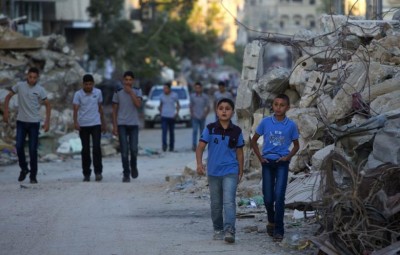War and Reconstruction: Gaza Struggles to Deal With 2.5 Million Tons of Rubble

The dead were buried and the wounded are trying to heal while the rubble of the war on Gaza remains in place. Hundreds of thousands of tons worth of rubble, not to mention the environmental and health hazard they pose, remind the survivors of death every morning. Removing the rubble means finally beginning the process of reconstruction and a return to normal life.
Despite the end of the war in Gaza, wherever its residents or visitors look, they are surrounded by the sight of rubble and ruin. Hundreds of thousands of tons of debris – remnants of the Israeli war – still block entire streets, prompting people to invent new bypass roads. Work has begun in some areas with the available resources to remove this rubble. However, delays in actual plans to clear all of it threaten the environment and health conditions of people here. Besides, some residents still search every day through the ruins of their homes, hoping to find something, or any of their belongings, especially important papers and documents.
According to preliminary figures published by the Ministry of Public Works, it is estimated that buildings destroyed during the 51-day war were reduced to 2.5 million tons of rubble. This figure is four times larger than that of the 2008-2009 Israeli war [on Gaza].
Gazan families are impatiently waiting for the removal of the piles of debris as they view it as a sign of the actual beginning of reconstruction. Otherwise, all the promises made are nothing but a smokescreen. This is the sense you get in the neighborhoods of al-Shujayeh in eastern Gaza, Beit Hanoun in northern Gaza and Khuzaa area in southern Gaza. Statistics also reveal that about 10,000 houses were totally destroyed and 30,000 were partially destroyed, including 5,000 houses that are in dire need of rehabilitation. The result is that 11,000 families are without shelter in addition to losing their basic resources.
Rubble for infilling parts of the sea and crushing it for reconstruction
Al-Akhbar contacted the under-secretary of the Ministry of Housing in Gaza, Naji Serhan, to ask what they are planning to do with the debris. He said that the government, in cooperation with specialized agencies, devised an emergency plan for 100 days to deal with this problem. The emergency plan includes clearing part of the rubble in addition to providing rent and alternative apartments for people whose houses were destroyed. “Temporary caravans were provided to shelter the rest of the families,” he added.
As for long-term plans, it is believed that part of the rubble will be crushed for use in building and construction. The rest will be used in building small dirt roads in the sea and consolidating the fishing port in Gaza, in addition to coastal areas overlooking the sea such as the eroded al-Shati Camp (Beach Camp), according to the under-secretary.
Serhan went on: “We can use the rubble in more than one area, but the most important thing is to remove it. Reusing it requires huge amounts of money that we currently do not have. Besides, building a port requires Israel’s approval. He pointed out that they were directly threatened by Israel when they built one dirt road in the sea before the war.
Despite these ideas, there is an ongoing public concern especially in light of the negative impact of the rubble. Abu Ali Darduna was one of the people who lost their homes in the war in addition to a small shop that constituted his livelihood. He is embarrassed because the rubble of his home is blocking a street which forces the rest of the area’s residents to take another road to get to their homes. He says no one came to check the debris to see if it contains hazardous materials. At the same time, he is worried that clearing the rubble quickly might lead to losing whatever is left of his belongings beneath it. Yet, he is afraid to look through the rubble in case there are unexploded ordinances.
Mouin Rajab, an economist in Gaza, believes that we can deal creatively with the tons of remaining rubble and benefit from it, “but there are more obstacles.” He estimates that to load and transfer this amount of rubble requires at least 60,000 trucks. He told Al-Akhbar that workers are going to face huge problems in crushing the rubble that is still held together “because it requires heavy equipment, especially in the case of the high-rise towers such as Basha Tower, Zafer Tower and the Italian Complex.”
Attorney and human rights activist at the Independent Commission for Human Rights, Salah Abdel Atti, thinks that we should let some of the destroyed sites stand as a testimony of Israeli crimes. He talked about the Lebanese experience as an example. “When some of the remnants of Lebanon’s civil war were left in the early 1990s to bear witness to the events and were only rebuilt after a while.” He went on to say: “I mean leave some evidence in a way that does not affect the people and the reconstruction project, especially the big towers.”

